DCS分布式控制系统中英文资料对照外文翻译文献综述
DCS分散控制系统中英文对照

DCS分散控制系统中英文对照DCS ................................ 分散控制系统BTG ----------- --------------- 常规摸拟仪表RUN BACK .................... -……自动快速减负荷RUN UP ................................. 强增负荷RUN DOWN ............................. 强减负荷FCB -- ---------- ------------- 快速甩负荷MFT -------- --- ------------- 锅炉主燃料跳闸TSI- ------------ --------------- 汽轮机监测系统ETS -- ----------- ------------ 汽轮机紧急跳机系统ATS -- -------- --------------- 汽轮机自启动系统AGC- ---------- --------------- 自动发电控制ADS- ---------- --------------- 调度自动化系统CCS ----------- --------------- 单元机组协调控制系统FSSS -------- --------------- 锅炉炉膛安全监控系统BMS- ................................ 燃烧管理系统SCS ............................... 顺序控制系统MCC ................................. 调节控制系统DAS ................................. 数据采集系统DEH- ------------ ------------- 数字电液调节系统MEH- ................................ 给水泵汽轮机数字电液调节系BPS .................................. 旁路控制系统DIS ................................... 数字显示站MCS .............. .. ... ..... .... 管理指令(模拟量控制)系统BM ................................... 锅炉主控TM ............ ................. --汽轮机主控DEB—— .............. ——协调控制原理ULD ............... ............ 机组负荷指令ABTC ............................... -CCS 的主控系统MLS .............. .................. 手动负荷设定器BCS ............................... 燃烧器控制系统PLC --- ----------- -- ---- --- 可编程控制器UAM .................................. 自动管理系统MTBF- ........... ----- ............ 平均故障间隔时间MTTR ........................... 平均故障修复时间SPC—— .. .... ........ ——定值控制系统OPC——....................... 超速保护控制系统ATC -------- ------ -…——自动汽轮机控制ETS…-……-……-…汽轮机危急遮断系统AST .......... .... ................ 自动危急遮断控制IMP ............... ......... ——调节级压力VP .................................... 阀位指令FA全周进汽PA ----------------------------- 部分进汽LVDT -------------------------- 线性位移差动转换器UMS --------------------------- 机组主控顺序TMS --------------------------- 机主控顺序BMS --------------------------- 炉主控顺序BFPT -------------------------- 给水泵汽轮机PID ---------------------------- 比例积分微分调节器BATCHDATA ------------------- -批数据节STEPSUBOUTINE .............. --- 步了程序节FUNCTIONSUBOUT E一•…- 功能子程序节MONITORSUBOUTINE—……监视子程序节MCR --------------------------- 最大连续出力ASP ---------------------------- 自动停导阀LOB ---------------------------- 润滑油压低LP ---------------------------- 调速油压低LV ---------------------------- 真空低OS ---------------------------- 超速PU ---------------------------- 发送器RP ---------------------------- 转子位置TB ----------------------------- 轴向位移DPU --------------------------- 分散控制单元MIS --------------------------- 自动化管理信息系统DEL ................................. DTE ................................ DCE ................................ RTU ................................ TXD ................................ RXD ................................ RTS ................................ CTS ................................OIS ................................ EWS .........................................MMI ................................. DHC ......................................... FP-——........................ . MFC ......................................... NMRR ......................................... CMRR .........................................OIU ..................................数据换码符数据终端设备数据通信设备远程终端发送数据接收数据请求发送结束发送数据装置准备好数据终端准备好工作站数据咼速公路DSR ................................DTR ................................ WORKSTATION .......................... DATAHIGHWAYS ....................... DATANETWORK ............... ——数据网络操作员站工程师站人机接口数据高速公路控制器功能处理器多功能处理器差模抑制比共模抑制比操作员接口MMU ............................... 端子安装单元CIU ......... ....... ............... 计算机接口单元COM -- ------ ---------------- 控制器模件LIM -------- --- --- ---- -- 回路接口模件LMM ................................... 逻辑主模件BIM ... ..... ... ... ............... 总线接口模件AMM ................................... 模拟主模件DSM ................................... 数字子模件DLS ------- --- --- -- --- ---- 数字逻辑站ASM- .................................. 模拟子模件DIS ----- ........ .. ……-----数字指示站CTS —— .......................... -控制I/O子模件TPL ................................. 通信回路端子单元TDI/IDO ------------- - ---- 数字输入/输出端子单元TAI/TAO ........................ 模拟输入/输出端子单元TLS ............................ 逻辑站端子单元TCS ------- --- --- ---- ---- 控制器站端子单元CTM——…… ... .............. 组态调整单元MBD ................................ 控制板LOG- ................................ 记录器站ENG- ............................... 工程师控制站HSR- ................................ 历史数据存储及检索站OPE ... .... ..................... -操作员/报警控制台CALC ............................... 记算机站MSV- ............................... 高压主汽阀MCV ............... . .............. 高压调节阀RSV- ................................ 中压主汽阀ICV ............. ................... 中压调节阀PPS…-……-……--…-汽轮机防进水保护系统ASS ................................. 自动同步BOP ........ ................ -…轴承润滑油泵EOP ................................. 紧急事故油泵SOP——.................. ——高压备用密封油泵CCBF-- .................... ..... 协调控制锅炉跟随方式CCTF -…------协调控制汽轮机跟随方式CRT——…一——……-阴极射线管GC-…一-…——……咼压调节阀控制IC……---…---…一--中压调节阀控制TC .................................. 高压主汽阀控制LDC .............. ................. 负荷指令计算机OA ............... ----- ........... 操作员自动控制PCV- ................................ 压力控制阀门TSI ................................. 汽轮机监控仪表TPC ................................. 汽轮机压力控制UPS ................................. 不间断电源。
控制系统基础论文中英文资料外文翻译文献
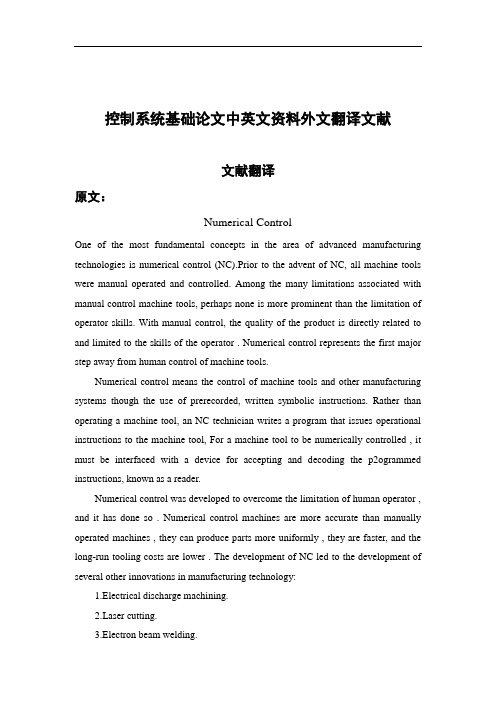
控制系统基础论文中英文资料外文翻译文献文献翻译原文:Numerical ControlOne of the most fundamental concepts in the area of advanced manufacturing technologies is numerical control (NC).Prior to the advent of NC, all machine tools were manual operated and controlled. Among the many limitations associated with manual control machine tools, perhaps none is more prominent than the limitation of operator skills. With manual control, the quality of the product is directly related to and limited to the skills of the operator . Numerical control represents the first major step away from human control of machine tools.Numerical control means the control of machine tools and other manufacturing systems though the use of prerecorded, written symbolic instructions. Rather than operating a machine tool, an NC technician writes a program that issues operational instructions to the machine tool, For a machine tool to be numerically controlled , it must be interfaced with a device for accepting and decoding the p2ogrammed instructions, known as a reader.Numerical control was developed to overcome the limitation of human operator , and it has done so . Numerical control machines are more accurate than manually operated machines , they can produce parts more uniformly , they are faster, and the long-run tooling costs are lower . The development of NC led to the development of several other innovations in manufacturing technology:1.Electrical discharge machining.ser cutting.3.Electron beam welding.Numerical control has also made machine tools more versatile than their manually operated predecessors. An NC machine tool can automatically produce a wide variety of par 4s , each involving an assortment of undertake the production of products that would not have been feasible from an economic perspective using manually controlled machine tools and processes.Like so many advanced technologies , NC was born in the laboratories of the Massachusetts Institute of Technology . The concept of NC was developed in the early 1950s with funding provided by the U.S Air Force .In its earliest stages , NC machines were able to make straight cuts efficiently and effectively.However ,curved paths were a problem because the machine tool had to be programmed to undertake a series of horizontal and vertical steps to produce a curve. The shorter is the straight lines making up the step ,the smoother is the curve . Each line segment in the steps had to be calculated.This problem led to the development in 1959 of the Automatically Programmed Tools (APT) language for NC that uses statements similar to English language to define the part geometry, describe the cutting tool configuration, and specify the necessary motions. The development of the APT language was a major step forward in the further development of NC technology. The original NC system were vastly different from those used punched paper , which was later to replaced by magnetic plastic tape .A tape reader was used to interpret the instructions written on the tape for the machine .Together, all of this represented giant step forward in the control of machine tools . However ,there were a number of problems with NC at this point in its development.A major problem was the fragility of the punched paper tape medium . It was common for the paper containing the programmed instructions to break or tear during a machining process, This problem was exacerbated by the fact that each successive time a part was produced on a machine tool, the paper tape carrying the programmed instructions had to rerun thought the reader . If it was necessary to produce 100 copies of a given part , it was also necessary to run the paper tape thought the reader 100 separate times . Fragile paper tapes simply could not withstand the rigors of shop floorenvironment and this kind of repeated use.This led to the development of a special magnetic tape . Whereas the paper tape carried the programmed instructions as a series of holes punched in the tape , theThis most mportant of these was that it was difficult or impossible to change the instructions entered on the tape . To make even the most minor adjustments in a program of instructions, it was necessary to interrupt machining operations and make a new tape. It was also still necessary to run the tape thought the reader as many times as there were parts to be produced . Fortunately, computer technology become a reality and soon solved the problems of NC, associated with punched paper and plastic tape.The development of a concept known as numerical control (DNC) solve the paper and plastic tape problems associated with numerical control by simply eliminating tape as the medium for carrying the programmed instructions . In direct numerical control, machine tools are tied, via a data transmission link, to a host computer and fed to the machine tool as needed via the data transmission linkage. Direct numerical control represented a major step forward over punched tape and plastic tape. However ,it is subject to the same limitation as all technologies that depend on a host computer. When the host computer goes down , the machine tools also experience down time . This problem led to the development of computer numerical control.The evelopment of the microprocessor allowed for the development of programmable logic controllers (PLC) and microcomputers . These two technologies allowed for the development of computer numerical control (CNC).With CNC , each machine tool has a PLC or a microcomputer that serves the same purpose. This allows programs to be input and stored at each individual machine tool. CNC solved the problems associated downtime of the host computer , but it introduced another problem known as data management . The same program might be loaded on ten different microcomputers with no communication among them. This problem is in the process of being solved by local area networks that connectDigital ignal Processors.There are numerous situations where analog signals to be processed in manyways, like filtering and spectral analysis , Designing analog hardware to perform these functions is possible but has become less and practical, due to increased performance requirements, flexibility needs , and the need to cut down on development/testing time .It is in other words difficult pm design analog hardware analysis of signals.The act of sampling an signal into thehat are specialised for embedded signal processing operations , and such a processor is called a DSP, which stands for Digital Signal Processor . Today there are hundreds of DSP families from as many manufacturers, each one designed for a particular price/performance/usage group. Many of the largest manufacturers, like Texas Instruments and Motorola, offer both specialised DSP‟s for certain fields like motor-control or modems ,and general high-performance SP‟s that can erform broad ranges of processing tasks. Development kits an software are also available , and there are companies making software development tools for DSP‟s that allows the programmer to implement complex processing algorithms using simple “drag …n‟ drop” methodologies.DSP‟s more or less fall into two categories depending on the underlying architecture-fixed-point and floating-point. The fixed-point devices generally operate on 16-bit words, while the floating-point devices operate on 32-40 bits floating-point words. Needless to say , the fixed-point devices are generally cheaper . Another important architectural difference is that fixed-point processors tend to have an accumulator architecture, with only one “general purpose” register , making them quite tricky to program and more importantly ,making C-compilers inherently inefficient. Floating-point DSP‟s behave more like common general-purpose CPU‟s ,with register-files.There are thousands of different DSP‟s on the market, and it is difficult task finding the most suitable DSP for a project. The best way is probably to set up a constraint and wishlist, and try to compare the processors from the biggest manufacturers against it.The “big four” manufacturers of DSP‟s: Texas Instruments, Motorola, AT&T and Analog Devices.Digital-to-analog conversionIn the case of MPEG-Audio decoding , digital compressed data is fed into the DSP which performs the decoding , then the decoded samples have to be converted back into the analog domain , and the resulting signal fed an amplifier or similar audio equipment . This digital to analog conversion (DCA) is performed by a circuit with the same name & Different DCA‟s provide different performance and quality , as measured by THD (Total harmonic distortion ), number of bits, linearity , speed, filter characteristics and other things.The TMS320 family DQP of Texas InstrumentsThe TLS320family consists of fixed-point, floating-point, multiprocessor digital signal processors (DSP‟s) , and foxed-point DSP controllers. TMS320 DSP have an architecture designed specifically for real-time signal processing . The F/C240 is a number of the‟C2000DSP platform , and is optimized for control applications. The C24x series of DSP controllers combines this real-time processing capability with controller peripherals to create an ideal solution for control system applications. The following characteristics make the TMS320 family the right choice for a wide range of processing applications:--- Very flexible instruction set--- Inherent operational flexibility---High-speed performance---Innovative parallel architecture---Cost effectivenessDevices within a generation of the TMS320 family have the same CPU structure but different on-chip memory and peripheral configurations. Spin-off devices use new combinations of On-chip memory and peripherals to satisfy a wide range of needs in the worldwide electronics market. By integrating memory and peripherals onto a single chip , TMS320 devices reduce system costs and save circuit board space.The 16-bit ,fixed-point DSP core of the C24x devices provides analog designers a digital solution that does not sacrifice the precision and performance of their system performance can be enhanced through the use of advanced control algorithms for techniques such as adaptive control , Kalman filtering , and state control. The C24xDSP controller offer reliability and programmability . Analog control systems, on the other hand ,are hardwired solutions and can experience performance degradation due to aging , component tolerance, and drift.The high-speed central processing unit (CPU) allows the digital designer to process algorithms in real time rather than approximate results with look-up tables. The instruction set of these DSP controllers, which incorporates both signal processing instructions and general-purpose control functions, coupled with the extensive development time and provides the same ease of use as traditional 8-and 16-bit microcontrollers. The instruction set also allows you to retain your software investment when moving from other general-purpose C2xx generation ,source code compatible with the C2x generation , and upwardly source code compatible with the C5x generation of DSPs from Texas Instruments.The C24x architecture is also well-suited for processing control signals. It uses a 16-bit word length along with 32-bit registers for storing intermediate results, and has two hardware shifters available to scale numbers independently of the CPU . This combination minimizes quantization and truncation errors, and increases p2ocessing power for additional functions. Such functions might include a notch filter that could cancel mechanical resonances in a system or an estimation technique that could eliminate state sensors in a system.The C24xDSP controllers take advantage of an set of peripheral functions that allow Texas Instruments to quickly configure various series members for different price/ performance points or for application optimization.This library of both digital and mixed-signal peripherals includes:---Timers---Serial communications ports (SCI,SPI)---Analog-to-digital converters(ADC)---Event manager---System protection, such as low-voltage and watchdog timerThe DSP controller peripheral library is continually growing and changing to suit the of tomorrow‟s e mbedded control marketplace.The TMS320F/C240 is the first standard device introduced in the …24x series of DSP controllers. It sets the standard for a single-chip digital motor controller. The 240 can execute 20 MIPS. Almost all instructions are executed in a simple cycle of 50 ns . This high performance allows real-time execution of very comple8 control algorithms, such as adaptive control and Kalman filters. Very high sampling rates can also be used to minimize loop delays.The 240 has the architectural features necessary for high-speed signal processing and digital control functions, and it has the peripherals needed to provide a single-chip solution for motor control applications. The 240 is manufactured using submicron CMOS technology, achieving a log power dissipation rating . Also included are several power-down modes for further power savings. Some applications that benefit from the advanced processing power of the 240 include:---Industrial motor drives---Power inverters and controllers---Automotive systems, such as electronic power steering , antilock brakes, and climate control---Appliance and HV AC blower/ compressor motor controls---Printers, copiers, and other office products---Tape drives, magnetic optical drives, and other mass storage products---Robotic and CNC milling machinesTo function as a system manager, a DSP must have robust on-chip I/O and other peripherals. The event manager of the 240 is unlike any other available on a DSP . This application-optimized peripheral unit , coupled with the high performance DSP core, enables the use of advanced control techniques for high-precision and high-efficiency full variable-speed control of all motor types. Include in the event manager are special pulse-width modulation (PWM) generation functions, such as a programmable dead-band function and a space vector PWM state machine for 3-phase motors that provides state-of-the-art maximum efficiency in the switching of power transistors.There independent up down timers, each with it‟s own compare register, supportthe generation of asymmetric (noncentered) as well as symmetric (centered) PWM waveforms.Open-Loop and Closed-Loop ControlOpen-loop Control SystemsThe word automatic implies that there is a certain amount of sophistication in the control system. By automatic, it generally means That the system is usually capable of adapting to a variety of operating conditions and is able to respond to a class of inputs satisfactorily . However , not any type of control system has the automatic feature. Usually , the automatic feature is achieved by feed.The feedback structure, it is called an open-loop system , which is the simplest and most economical type of control system.inaccuracy lies in the fact that one may not know the exact characteristics of the further ,which has a definite bearing on the indoor temperature. This alco points to an important disadvantage of the performance of an open -loop control system, in that the system is not capable of adapting to variations in environmental conitions or to external disturbances. In the case of the furnace control, perhaps an experienced person can provide control for a certain desired temperature in the house; but id the doors or windows are opened or closed intermittently during the operating period, the final temperature inside the house will not be accurately regulated by the open-loop control.An electric washing machine is another typical example of an open-loop system , because the amount of wash time is entirely determined by the judgment and estimation of the human operator . A true automatic electric washing machine should have the means of checking the cleanliness of the clothes continuously and turn itsedt off when the desired degised of cleanliness is reached.Closed-Loop Control SystemsWhat is missing in the open-loop control system for more accurate and more adaptable control is a link or feedback from the output to the input of the system . In order to obtain more accurate bontrol, the controlled signal c(t) must be fed back and compared with the reference input , and an actuating signal proportional to the difference of the output and the input must be sent through the system to correct theerror. A system with one or more feedback pats like that just described is called a closed-loop system. human being are probably the most complex and sophisticated feedback control system in existence. A human being may be considered to be a control system with many inputs and outputs, capable of carrying out highly complex operations.To illustrate the human being as a feedback control system , let us consider that the objective is to reach for an object on aperform the task. The eyes serve as a sensing device which feeds back continuously the position of the hand . The distance between the hand and the object is the error , which is eventually brought to zero as the hand reacher the object. This is a typical example of closed-loop control. However , if one is told to reach for the object and then is blindolded, one can only reach toward the object by estimating its exact position. It is As anther illustrative example of a closed-loop control system, shows the block diagram of the rudder control system of The basic alements and the bloca diagram of a closed-loop control system are shown in fig. In general , the configuration of a feedback control system may not be constrained to that of fig & . In complex systems there may be multitude of feedback loops and element blocks.译文:控制系统基础数字控制机床常常重达上百吨,但却常常要求切削工具的定位精度达到0.002毫米。
DCS教程资料和引进型机组DCS画面常用英语词汇
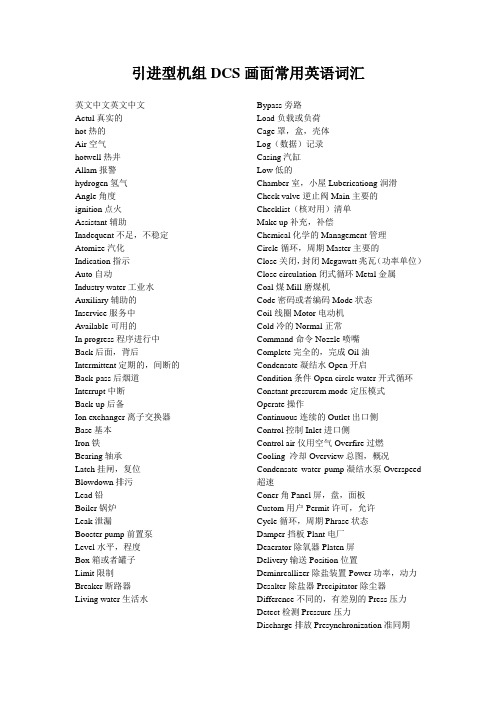
引进型机组DCS画面常用英语词汇英文中文英文中文Actul真实的hot热的Air空气hotwell热井Allam报警hydrogen氢气Angle角度ignition点火Assistant辅助Inadequent不足,不稳定Atomize汽化Indication指示Auto自动Industry water工业水Auxiliary辅助的Inservice服务中A vailable可用的In progress程序进行中Back后面,背后Intermittent定期的,间断的Back-pass后烟道Interrupt中断Back-up后备Ion exchanger离子交换器Base基本Iron铁Bearing轴承Latch挂闸,复位Blowdown排污Lead铅Boiler锅炉Leak泄漏Booster pump前置泵Level水平,程度Box箱或者罐子Limit限制Breaker断路器Living water生活水Bypass旁路Load负载或负荷Cage罩,盒,壳体Log(数据)记录Casing汽缸Low低的Chamber室,小屋Lubericationg润滑Check valve逆止阀Main主要的Checklist(核对用)清单Make up补充,补偿Chemical化学的Management管理Circle循环,周期Master主要的Close关闭,封闭Megawatt兆瓦(功率单位)Close circulation闭式循环Metal金属Coal煤Mill磨煤机Code密码或者编码Mode状态Coil线圈Motor电动机Cold冷的Normal正常Command命令Nozzle喷嘴Complete完全的,完成Oil油Condensate凝结水Open开启Condition条件Open circle water开式循环Constant pressurem mode定压模式Operate操作Continuous连续的Outlet出口侧Control控制Inlet进口侧Control air仪用空气Overfire过燃Cooling 冷却Overview总图,概况Condensate water pump凝结水泵Overspeed 超速Coner角Panel屏,盘,面板Custom用户Permit许可,允许Cycle循环,周期Phrase状态Damper挡板Plant电厂Deaerator除氧器Platen屏Delivery输送Position位置Deminreallizer除盐装置Power功率,动力Desalter除盐器Precipitator除尘器Difference不同的,有差别的Press压力Detect检测Pressure压力Discharge排放Presynchronization准同期Display显示Primary初始的,一次风Drain疏水Proven已经被确认Drum汽包Plse脉冲Economizer省煤器Pulverizer磨煤机Electrical电的,电力的Pump泵Eleation层Purge吹扫Emergency紧急情况Purity纯度Enter进入,开始执行Push-botton按钮Exchanger交换器Rate速率Exciter励磁机Ready准备Execute执行Rear后部Exhaust排汽(气)Relation关系Expansion膨胀Remote远方,遥控Extraction抽取Reservoir存储容器Failure失败Returm返回Fan风机Ring环形的Fault故障Roll转动Feedback反馈Run运行Feeder给煤机Satisfactory满足Feedwater给水Scanner扫描器Feed water pump给水泵Seal密封Filter滤网,过滤器Second第二,秒Flame火焰Sequential顺序的Final最后Set设置Flap振动,拍打Setpoint设定值Flow流动,流量Shallow浅层Flue燃料Shut valve截止阀,关断阀Front前面的Simulate仿镇Fule master主燃料Single单一的Furnace炉膛Slide pressure mode滑压状态Gas气体Speed速度Gate门,挡板Spray喷水Gear齿轮Stack烟囱Gearbox齿轮箱,变速箱Stage(汽机)级Generator发电机Standby备用(状态)Gland格兰,轴封Start-up启动Go执行Stator定子Govenor valve调节阀Status状态,特征Graphics图象,画面Steam蒸汽Guide引导Stop-valve截止阀Header联箱Storage存储Heat value热值Suplly供应,供给Heater加热器Support支持High高的Surge喘振,波动Hold把握,控制,保持System系统Hopper料斗Tag name标识,编号Horizontal水平的Tank箱,罐V acuum真空Target目标V acuum breaking valve真空破坏门test试验V alve阀门Throttle节流阀V ent通风,排空气Thrust bearing推力轴承Walll墙,管壁Tilt角度,摆角Warm-up暖炉(机,管)Total总的Washing water清洗水Tower塔Waterwall水冷壁Trip跳闸,停机windbox风箱Turbine汽轮机First out首出(原因)Unit单元Extraction抽,取Unsuccessful不成功的DCS画面常用常用缩写词语英文中文英文中文1ST1级FRQ频率A报警FSH末级过热器ADS自动调度系统FSSS炉膛安全监测系统AGC自动发电机控制FW给水AH空气预热器FWP给水泵AS轴向位移GC高压调门控制A TC汽轮机自动控制GEN发电机AUTO自动GV(高压)调节汽门AUX辅助的HH高高BASE基本HA V暖通BCP炉水循环泵HDR联箱,集箱BD排污HP高压缸BF锅炉跟随HTR加热器BFP锅炉给水泵IC中压调门控制BMCR锅炉最大连续出力ID标志,标识BMP燃烧器管理系统IDF引风机BOP轴承油泵IMP冲动式(级)BP旁路INCR提高,增加BRG轴承INTERM定期,间断BTG锅炉-汽机-发电机IV中压调门C切换LL低低CAF冷却风机LDC负荷指令计算机CAMP控制+报警+监测+保护LOP顶轴油泵CCCW闭式循环冷却水Lp低压CCS协调控制系统LSH低温过热器CDSR凝汽器LUB润滑油COND凝结MANU手动(方式)CON连续的MCR最大连续出力COOR连续的MCS模拟量控制系统CORR校正,修正MEH小型汽轮机电液调节CRT显示器MFT主燃料失去保护CRH低温再热器MIN最小CSH包覆过热器MS主蒸汽CW循环水MW兆瓦D NO编号,第。
集散型控制系统 毕业设计外文文献翻译
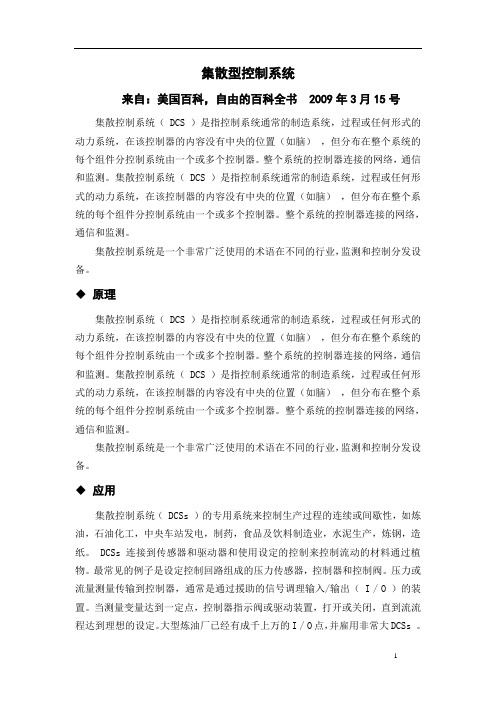
集散型控制系统来自:美国百科,自由的百科全书 2009年3月15号集散控制系统( DCS )是指控制系统通常的制造系统,过程或任何形式的动力系统,在该控制器的内容没有中央的位置(如脑),但分布在整个系统的每个组件分控制系统由一个或多个控制器。
整个系统的控制器连接的网络,通信和监测。
集散控制系统( DCS )是指控制系统通常的制造系统,过程或任何形式的动力系统,在该控制器的内容没有中央的位置(如脑),但分布在整个系统的每个组件分控制系统由一个或多个控制器。
整个系统的控制器连接的网络,通信和监测。
集散控制系统是一个非常广泛使用的术语在不同的行业,监测和控制分发设备。
◆原理集散控制系统( DCS )是指控制系统通常的制造系统,过程或任何形式的动力系统,在该控制器的内容没有中央的位置(如脑),但分布在整个系统的每个组件分控制系统由一个或多个控制器。
整个系统的控制器连接的网络,通信和监测。
集散控制系统( DCS )是指控制系统通常的制造系统,过程或任何形式的动力系统,在该控制器的内容没有中央的位置(如脑),但分布在整个系统的每个组件分控制系统由一个或多个控制器。
整个系统的控制器连接的网络,通信和监测。
集散控制系统是一个非常广泛使用的术语在不同的行业,监测和控制分发设备。
◆应用集散控制系统( DCSs )的专用系统来控制生产过程的连续或间歇性,如炼油,石油化工,中央车站发电,制药,食品及饮料制造业,水泥生产,炼钢,造纸。
DCSs连接到传感器和驱动器和使用设定的控制来控制流动的材料通过植物。
最常见的例子是设定控制回路组成的压力传感器,控制器和控制阀。
压力或流量测量传输到控制器,通常是通过援助的信号调理输入/输出( I / O )的装置。
当测量变量达到一定点,控制器指示阀或驱动装置,打开或关闭,直到流流程达到理想的设定。
大型炼油厂已经有成千上万的I / O点,并雇用非常大DCSs 。
进程不仅限于流体流经管道,但是,也包括像纸机及其相关的可变速驱动器和马达控制中心,水泥窑,采矿作业,矿石加工设施,以及其他许多人。
电厂dcs英语
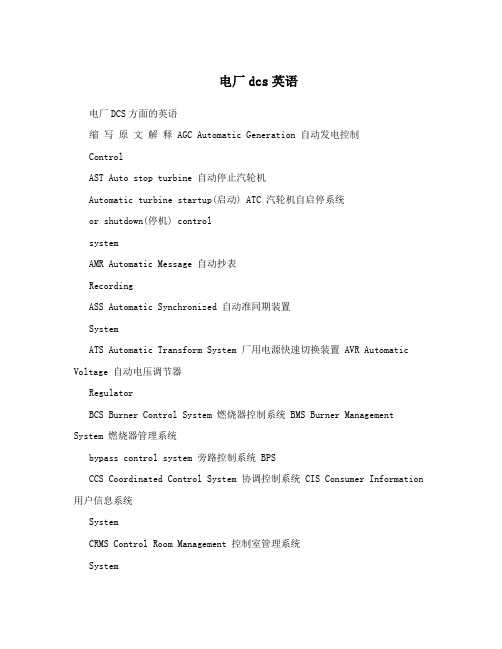
电厂dcs英语电厂DCS方面的英语缩写原文解释 AGC Automatic Generation 自动发电控制ControlAST Auto stop turbine 自动停止汽轮机Automatic turbine startup(启动) ATC 汽轮机自启停系统or shutdown(停机) controlsystemAMR Automatic Message 自动抄表RecordingASS Automatic Synchronized 自动准同期装置SystemATS Automatic Transform System 厂用电源快速切换装置 AVR Automatic Voltage 自动电压调节器RegulatorBCS Burner Control System 燃烧器控制系统 BMS Burner Management System 燃烧器管理系统bypass control system 旁路控制系统 BPSCCS Coordinated Control System 协调控制系统 CIS Consumer Information 用户信息系统SystemCRMS Control Room Management 控制室管理系统SystemCRT Cathode Ray Tube 阴极射线管 DA Distribution Automation 配电自动化 DAS Data Acquisition System 数据采集与处理系统 DCS DistributedControl System 分散控制系统 DDC Direct Digital Control 直接数字控制(系统) DEH Digital Electronic 数字电液(调节系统)Hydraulic ControlDMS Distribution Management 配电管理系统SystemDPU Distributed Processing 分布式处理单元UnitDSM Demand Side Management 需求侧管理 EMS Energy Management System能量管理系统 ETS Emergency Trip System 汽轮机紧急跳闸系统 EWSEngineering Working 工程师工作站StationFA Feeder Automation 馈线自动化 FCS Fieldbus Control System 现场总线控制系统 FSS Fuel Safety System 燃料安全系统 FSSS Furnace Safeguard 炉膛安全监控系统Supervisory SystemFCB fast cut back 快速返回 FTU Feeder Terminal Unit 馈线远方终端火灾报警系统 FGSGIS Gas Insulated Switchgear 气体绝缘开关设备 GPS Global Position System 全球定位系统 HCS Hierarchical Control 分级控制系统SystemLCD Liquid Crystal Display 液晶显示屏 LCP Local Control Panel 就地控制柜 LBP Low-pressure by-pass valve 低压旁路 MCC Motor Control Center(电动机)马达控制中心 MFT main fuel trip 主燃料跳闸 MCS Modulating Control System 模拟量控制系统 MEH Micro Electro 给水泵汽轮机电波控制系Hydraulic Control System 统MIS Management Information 管理信息系统SystemNCS Net Control System 网络监控系统 OIS Operator Interface Station 操作员接口站 OMS Outage Management System 停电管理系统燃油跳闸 OFT Oil fuel trip超速保护控制 OPC Overspeed protection CONTROLPAS Power Application Software 电力应用软件 PID Proportion Integration 比例积分微分DifferentiationPIO Process Input Output 过程输入输出(通道) PLC Programmable Logical 可编程逻辑控制器ControllerPSS Power System Stabilizator 电力系统稳定器 RTU Remote Terminal Unit 站内远方终端runback (辅机故障)快速甩负荷 RBrundown 负荷迫降 RD迫升负荷; RUN UP RUN UPSA Substation Automation 变电站自动化SCADA Supervisory Control And 数据采集与监控系统Data AcquisitionSCC Supervisory Computer 监督控制系统ControlSCS Sequence Control System 顺序(程序)控制系统SIS Supervisory Information 监控信息系统SystemSOE 事件顺序记录 Sequence of eventsTDCS Total Direct Digital 集散控制系统ControlTSI Turbine Supervisory 汽轮机监测仪表InstrumentationUPS Uninterrupted Power Supply 不间断供电WMS Work Management System 工作管理系统注:1、DEH系统的自动(ATC)包括自启动ATC和带负荷ATC。
(整理)DCS调试中英文版.
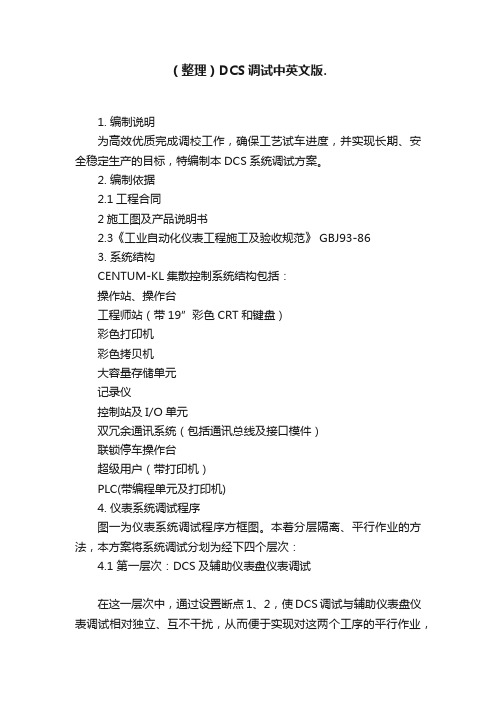
(整理)DCS调试中英文版.1. 编制说明为高效优质完成调校工作,确保工艺试车进度,并实现长期、安全稳定生产的目标,特编制本DCS系统调试方案。
2. 编制依据2.1工程合同2施工图及产品说明书2.3《工业自动化仪表工程施工及验收规范》 GBJ93-863. 系统结构CENTUM-KL集散控制系统结构包括:操作站、操作台工程师站(带19”彩色CRT和键盘)彩色打印机彩色拷贝机大容量存储单元记录仪控制站及I/O单元双冗余通讯系统(包括通讯总线及接口模件)联锁停车操作台超级用户(带打印机)PLC(带编程单元及打印机)4. 仪表系统调试程序图一为仪表系统调试程序方框图。
本着分层隔离、平行作业的方法,本方案将系统调试分划为经下四个层次:4.1 第一层次:DCS及辅助仪表盘仪表调试在这一层次中,通过设置断点1、2,使DCS调试与辅助仪表盘仪表调试相对独立、互不干扰,从而便于实现对这两个工序的平行作业,并可避免因设备状态不正常或接线错误等原因造成设备的损坏。
4.2 第二层次:控制室内部系统调试此层次在不连接控制至现场电缆情况下,对DCS机柜、压缩机盘、火警盘等的系统调试。
对于其中的联锁系统调试能否做早、做好、做扎实,对“消除隐患、掌握主动、赢得时间”意义重大。
4.3 第三层次:全装置仪表二次联校根据现场施工及工艺试车进度要求,逐点连接控制室至现场电缆,通过在现场加信号进行回路试验,并陆续投用。
4.4 第四层次:应用软件参数的进一步调整此为在单体试车、联动试车之前、之中、之后,对某些仪表参数如复杂调节系统的计算系数、偏置值、延迟时间、设定值及比例度、积分、微分时间等的试验调整,以获得最佳运行工况。
5. 调试内容及方法Content and Method of testing:5.1 DCS调试现场调试工作主要是检查使用系统软件,并对应用软件进行组态确认和功能测试。
Local testing mainly including: checking and applying system software.Executing function approval and function test.5.1.1 通电前的检查Inspection prior to making contact.电缆绝缘电阻符合要求(大于5M欧),查看电缆绝缘电阻测试记录,必要时抽查实测。
分布式控制系统(dcs)设计与应用实例 英文版
分布式控制系统(dcs)设计与应用实例英文版I. IntroductionIntroduction:Distributed Control Systems (DCS) represent a pivotal technology in industrial automation, offering efficient and reliable control over complex processes across multiple locations. These systems decentralize control functions, enhancing system resilience and flexibility.Intrduction:分布式控制系统(DCS)在工业自动化领域扮演着关键角色,能有效并可靠地对多个地点的复杂流程进行控制。
这些系统通过分散控制功能,提升了系统的抗风险能力和灵活性。
II. DCS Design PrinciplesDesign Fundamentals:The design of a DCS revolves around the principle of modularity and redundancy. It consists of controllers, sensors, actuators, and human-machine interfaces (HMIs), all interconnected through a communication network. Each component is designed to perform specific tasks while maintaining real-time data exchange for coordinatedoperation.设计基础:DCS的设计以模块化和冗余性原则为核心。
DCS常用单词中英文对照讲解
DCS常用单词中英文对照讲解英文全称( front ) big platen 1st e_traction abnormal accident acknowledge act activeactive power adjusting admission AirAir flow air leakage air preheater air side alarmalarm window all phasesalternating current area areaash hopperatmospheric relief valve atomizing attemperatingattemperator,desuperheater automatic Au_iliarya_ial displacement Backbe out of order bearing Bearing bo_Bearing vibration begin behind belt binbin, pulverized coal bunker 英文缩写 BIG PLTN 1ST E_TR ABNM ACDT ACK ACT ACTIVE A_PW ADJ ADMS AIRAIR FLOW AL APH AIR_S ALM ALM WIN 3 PH AC AREA AREA ASH HOP ATM REL VLV ATOM DT DTR AUTO AU_A_I DISP BAN_ORDER BEAR BEAR BO_ BEAR VIB BEGIN BH BELT BIN BIN 中文大屏一段抽汽异常事故确认动作激励有功功率调整进汽空气风量漏风空预器空侧报警光字牌全相交流分区区灰斗对空排汽门雾化减温减温器自动辅助轴向位移后失灵轴承轴承箱轴振开始在…的后面皮带煤粉仓粉仓blocking Blowdown blowdown bobbin body Boilerboiler feeder water pump turbine boiler hall booster pump Bottom bowlbo_ Branch breaker buchholtz Burnerburning e_haust bus Bushbutterfly valve bypass Cabinet calculationcation e_changer ceiling Center Channel Charge Checkcheck valve, non-return valve Chief Circuit circulatingcirculating water classifier cleanclose command close switch Closedclosed circulating cooling water BLOCK BLDN BLOWDOWN BBIN BODY BLR BFPT BLR HALL BP BTM BOWL BO_ BRCH BRK BCHTZ BNR BRNHT BUS BUSH BFV BYP CAB CAL CATION E_CHANGER CLNG CTR CHANL CHARGE CHKCHK V,CHKV CHFCIRCUIT CIRC CIRC WTR CLSFER CLEANCLS CMD,CLOS CMD CLS SWTH CLSD CCCW 堵塞排污锅炉排污筒体本体锅炉小汽机锅炉房前置泵底磨碗盒分支,支路断路器瓦斯燃烧器燃尽母线轴瓦蝶阀旁路机柜计算阳离子交换器顶棚中心通道充电校正逆止门总电路循环循环水粗粉分离器净关命令合闸已关, 关状态闭式循环冷却水coal blocking coal carry coal conveyer coal feedercoal mill,coal pulverizer Cobblestone cog coil cold air collar Collection collection water pump combined steam valve Combiner command Commoncommon transformer Comple_ composecompressed air condensatecondensate pump condensated water condenser conductivity connector Containercontinue blowdowncontinue blowdown flashtank Control control bo_Control commmand control room converge cooler coolingcooling air (blower) fan corner coupler crevice COAL BLOCK COAL_CARY COAL CVRCOAL FDR,FDR MILL,PULV STONE COG COIL CLD AIR COLLAR CLCTCLCT W_PMP CSV COMBNR CMD COMC__FMR,C_ COMP CMPSCPRESS AIR CNDS CNDS PMP CNDS WTR COND CONDUCT CNTR CTNR CTN BLDN CBFT CTL CTL BO_ CTL CMD CTL ROOM CNVG CLR CLGCLG AIR FAN,CAF CRNR CPLR CRVC 堵煤输煤输煤机给煤机磨煤机石子齿部线圈冷风轭部收集收集水泵联合汽门组件指令,命令公用公用变复合合成压缩空气凝结凝结水泵凝结水凝汽器导电度连通管罐连排连排扩容器控制控制箱控制命令(对调节阀) 控制室汇流冷却器冷却冷却风机角耦合器夹层crevice currentcustomer valvecut off the water supply cyclone separator cylindercylinder crevice damper deaerator decreasededust transformer demagnetizer DemandDemineralizedDemineralized device Density Dewater Diaphragm diesel engine differentialdifferential pressure direct current dirtyDirty oil chamber disappear Discharge Discharge oil Discharge steamdischarge water disconnecting displace dissolved downdowncomer Draftdrain tank drain waterdrain water flashtank drain water to deae drain water VLV CRVC CURT CV WTR CUT CSEP CYLCYL CRVC DMPR DEAE DECDEDUST__FMR DEMAG DMD DEMINE DEMINER DNSTY DWTR DPHRM DSL DIFF DP DC DIRTY DTY OC DSPPR DISCH DISCH OIL DISCH STM DISCH WTR DISCON DISP DSSLV DN DNCMR DRAFT DRN TK DRNDRN FLTK DRN-DEAE DRN VLV 间隙电流用户阀断水细粉分离器汽缸汽缸夹层挡板除氧器减少电除尘变消磁装置要求除盐的除盐装置浓度脱水隔膜柴油机差动差压直流脏污油室消失泄放放油放汽放水断线位移溶解下下降管通风疏水罐疏水疏水扩容器疏水至除氧器疏水阀Dregs drive end DrumDuplicatedust transformer Ecentricity EH oil Electricelectric magnetic electric motor electrical work Emergency Emergency emergency drain wateremergency relieve oil valve enconomizer endEnd faceenergy storage equipment e_changer e_citation e_citatore_citator side E_hauste_haust gas fan E_haust oil E_haust steam E_haust water E_haustere_pansione_pansion difference e_plosion vent E_tende_traction steame_traction steam to deaerator failurefast-closing Fault feedback DRG DRV_E DRUM DUPDST__FMR ECENEH OIL, EHO ELEC MAG MTR KWh EMG EMGEMG DRN WTR EMG RLV OIL VLV ECON ENDEND FACE ENERGY_STG EQPMNT E_CHR E_CT E_CTRE_CTR SIDE E_H EGF E_H OIL E_H STM E_H WTR E_HR E_PE_P DIFF E_P VENT E_TD E_TR E_T_DEAE FAIL FAST CLS FAULT,FLT FDB 渣驱动端汽包复除灰变偏心度抗燃油电气电磁电机(电动机) 电度紧急事故事故疏水紧急放油阀省煤器结束端蓄能器装置交换器励磁励磁机励端排风排烟风机排油排汽排水排风机膨胀胀差防爆门伸进抽汽抽汽至除氧器失败速断故障反馈。
DCS中英文对照表(缩写和全称)
分类 专设 专设 位置 位置
通设 单位
电设备 功能 功能 功能 通设 通设 通设
功能 介质 状态 状态 状态 单位 专设 介质 介质 功能
通设 位置 位置 位置 位置 功能 单位 电设备 电设备 电设备 位置 电设备 位置 功能 单位 状态 功能 功能
国电热工研究院
第1页
四川广安发电有限责任公司二期工程DCS系统英汉对照表
英文全称
分类
flange
专设
tippler
功能
feedback
功能
reverse
状态
reversal rotation
功能
mode
功能
Discharge steam
功能
discharge water
功能
Dischar drive end
位置
isolating platen
国电热工研究院
第3页
四川广安发电有限责任公司二期工程DCS系统英汉对照表
排序 F T F R R M D D D N N I S A B B P A W A L P T R V H H H H H H H H H H H H H I P C F I W O O
英文缩写 FLAN TPLR FDBK RVRS RRT MODE
功能
High
状态
high voltage standby transformer 电设备
high voltage
状态
high pressure auxiliary
专设
high pressure header
专设
high energy spark ignitor
专设
high speed
电气专业英语(中英文对照表)
电气专业英语AGC Automatic Generation Control 自动发电控制AMR Automatic Message Recording 自动抄表ASS Automatic Synchronized System 自动准同期装置ATS Automatic Transform System 厂用电源快速切换装置AVR Automatic Voltage Regulator 自动电压调节器BCS Burner Control System 燃烧器控制系统BMS Burner Management System 燃烧器管理系统CCS Coordinated Control System 协调控制系统CRMS Control Room Management System 控制室管理系统CRT Cathode Ray Tube 阴极射线管DAS Data Acquisition System 数据采集与处理系统DCS Distributed Control System 分散控制系统DDC Direct Digital Control 直接数字控制(系统)DEH Digital Electronic Hydraulic Control 数字电液(调节系统) DPU Distributed Processing Unit 分布式处理单元EMS Energy Management System 能量管理系统ETS Emergency Trip System 汽轮机紧急跳闸系统EWS Engineering Working Station 工程师工作站FA Feeder Automation 馈线自动化FCS Fieldbus Control System 现场总线控制系统FSS Fuel Safety System 燃料安全系统FSSS Furnace Safeguard Supervisory System 炉膛安全监控系统GIS Gas Insulated Switchgear 气体绝缘开关设备GPS Global Position System 全球定位系统HCS Hierarchical Control System 分级控制系统LCD Liquid Crystal Display 液晶显示屏LCP Local Control Panel 就地控制柜MCC Motor Control Center (电动机)马达控制中心MCS Modulating Control System 模拟量控制系统MEH Micro Electro Hydraulic Control System 给水泵汽轮机电液控制系统MIS Management Information System 管理信息系统NCS Net Control System 网络监控系统OIS Operator Interface Station 操作员接口站OMS Outage Management System 停电管理系统PID Proportion Integration Differentiation 比例积分微分PIO Process Input Output 过程输入输出(通道)PLC Programmable Logical Controller 可编程逻辑控制器PSS Power System Stabilizator 电力系统稳定器SCADA Supervisory Control And Data Acquisition 数据采集与监控系统SCC Supervisory Computer Control 监督控制系统SCS Sequence Control System 顺序(程序)控制系统SIS Supervisory Information System 监控信息系统TDCS(TDC) Total Direct Digital Control 集散控制系统TSI Turbine Supervisory Instrumentation 汽轮机监测仪表UPS Uninterrupted Power Supply 不间断供电。
- 1、下载文档前请自行甄别文档内容的完整性,平台不提供额外的编辑、内容补充、找答案等附加服务。
- 2、"仅部分预览"的文档,不可在线预览部分如存在完整性等问题,可反馈申请退款(可完整预览的文档不适用该条件!)。
- 3、如文档侵犯您的权益,请联系客服反馈,我们会尽快为您处理(人工客服工作时间:9:00-18:30)。
DCS分布式控制系统中英文资料对照外文翻译文献综述中文:DCSDCS是分布式控制系统的英文缩写(Distributed Control System),在国内自控行业又称之为集散控制系统。
即所谓的分布式控制系统,或在有些资料中称之为集散系统,是相对于集中式控制系统而言的一种新型计算机控制系统,它是在集中式控制系统的基础上发展、演变而来的。
它是一个由过程控制级和过程监控级组成的以通信网络为纽带的多级计算机系统,综合了计算机,通信、显示和控制等4C技术,其基本思想是分散控制、集中操作、分级管理、配置灵活以及组态方便。
在系统功能方面,DCS和集中式控制系统的区别不大,但在系统功能的实现方法上却完全不同。
首先,DCS的骨架—系统网络,它是DCS的基础和核心。
由于网络对于DCS 整个系统的实时性、可靠性和扩充性,起着决定性的作用,因此各厂家都在这方面进行了精心的设计。
对于DCS的系统网络来说,它必须满足实时性的要求,即在确定的时间限度内完成信息的传送。
这里所说的“确定”的时间限度,是指在无论何种情况下,信息传送都能在这个时间限度内完成,而这个时间限度则是根据被控制过程的实时性要求确定的。
因此,衡量系统网络性能的指标并不是网络的速率,即通常所说的每秒比特数(bps),而是系统网络的实时性,即能在多长的时间内确保所需信息的传输完成。
系统网络还必须非常可靠,无论在任何情况下,网络通信都不能中断,因此多数厂家的DCS均采用双总线、环形或双重星形的网络拓扑结构。
为了满足系统扩充性的要求,系统网络上可接入的最大节点数量应比实际使用的节点数量大若干倍。
这样,一方面可以随时增加新的节点,另一方面也可以使系统网络运行于较轻的通信负荷状态,以确保系统的实时性和可靠性。
在系统实际运行过程中,各个节点的上网和下网是随时可能发生的,特别是操作员站,这样,网络重构会经常进行,而这种操作绝对不能影响系统的正常运行,因此,系统网络应该具有很强在线网络重构功能。
其次,这是一种完全对现场I/O处理并实现直接数字控制(DDC)功能的网络节点。
一般一套DCS中要设置现场I/O控制站,用以分担整个系统的I/O和控制功能。
这样既可以避免由于一个站点失效造成整个系统的失效,提高系统可靠性,也可以使各站点分担数据采集和控制功能,有利于提高整个系统的性能。
DCS 的操作员站是处理一切与运行操作有关的人机界面(HMI-Human Machine Interface或operator interface)功能的网络节点。
工程师站是对DCS进行离线的配置、组态工作和在线的系统监督、控制、维护的网络节点,其主要功能是提供对DCS进行组态,配置工作的工具软件(即组态软件),并在DCS在线运行时实时地监视DCS网络上各个节点的运行情况,使系统工程师可以通过工程师站及时调整系统配置及一些系统参数的设定,使DCS 随时处在最佳的工作状态之下。
与集中式控制系统不同,所有的DCS都要求有系统组态功能,可以说,没有系统组态功能的系统就不能称其为DCS。
DCS自1975年问世以来,已经经历了二十多年的发展历程。
在这二十多年中,DCS虽然在系统的体系结构上没有发生重大改变,但是经过不断的发展和完善,其功能和性能都得到了巨大的提高。
总的来说,DCS正在向着更加开放,更加标准化,更加产品化的方向发展。
作为生产过程自动化领域的计算机控制系统,传统的DCS仅仅是一个狭义的概念。
如果以为DCS只是生产过程的自动化系统,那就会引出错误的结论,因为现在的计算机控制系统的含义已被大大扩展了,它不仅包括过去DCS中所包含的各种内容,还向下深入到了现场的每台测量设备、执行机构,向上发展到了生产管理,企业经营的方方面面。
传统意义上的DCS现在仅仅是指生产过程控制这一部分的自动化,而工业自动化系统的概念,则应定位到企业全面解决方案,即total solution 的层次。
只有从这个角度上提出问题并解决问题,才能使计算机自动化真正起到其应有的作用。
DCS具有以下特点:(1)高可靠性。
由于DCS将系统控制功能分散在各台计算机上实现,系统结构采用容错设计,因此某一台计算机出现的故障不会导致系统其他功能的丧失。
此外,由于系统中各台计算机所承担的任务比较单一,可以针对需要实现的功能采用具有特定结构和软件的专用计算机,从而使系统中每台计算机的可靠性也得到提高。
(2)开放性。
DCS采用开放式,标准化、模块化和系列化设计,系统中各台计算机采用局域网方式通信,实现信息传输,当需要改变或扩充系统功能时,可将新增计算机方便地连入系统通信网络或从网络中卸下,几乎不影响系统其他计算机的工作。
错误!未指定书签。
DCS的发展历史DCS是分布式控制系统的英文缩写(Distributed Control System),在国内自控行业又称之为集散控制系统。
它是一个由过程控制级和过程监控级组成的以通信网络为纽带的多级计算机系统,综合了计算机(Computer)、通讯(Communication)、显示(CRT)和控制(Control)等4C技术,其基本思想是分散控制、集中操作、分级管理、配置灵活、组态方便。
)它的发展大体分为三个阶段。
第一阶段:1975-1980年,在这个时期集散控制系统的技术特点表现为:1)采用微处理器为基础的控制单元,实现分散控制,有各种各样的算法,通过组态独立完成回路控制,具有自诊断功能2)采用带CRT显示器的操作站与过程单元分离,实现集中监视,集中操作3)采用较先进的冗余通信系统第二阶段:1980—1985.,在这个时期集散控制系统的技术特点表现为:1)微处理器的位数提高,CRT显示器的分辨率提高2)强化的模块化系统3)强化了系统信息管理,加强通信功能第三阶段,1985年以后,集散系统进入第三代,其技术特点表现为:1)采用开放系统管理2)操作站采用32位微处理器3)采用实时多用户多任务的操作系统进入九十年代以后,计算机技术突飞猛进,更多新的技术被应用到了DCS 之中。
PLC是一种针对顺序逻辑控制发展起来的电子设备,它主要用于代替不灵活而且笨重的继电器逻辑。
现场总线技术在进入九十年代中期以后发展十分迅猛,以至于有些人已做出预测:基于现场总线的FCS将取代DCS成为控制系统的主角。
DCS是 Data Communication Subsystem (数据通信子系统)的简称。
以轨道交通行业为例,DCS是一个纯透明的非安全性系统,他是控制中心和列车之间发送报文的载体。
DCS第二层涵义:Dorsal Column Stimulator[医]脊柱刺激器在特殊控制领域,如核电站控制系统,DCS的含义为数字化控制系统(Digital control system)。
国内DCS主要厂家有:上海新华,鲁能控制,国电智深,浙大中控,和利时,上海华文,上海乐华,浙江中自等。
国外的有西屋(艾默生)、FOXBORO、ABB、西门子、霍尼韦尔、横河、山武-霍尼韦尔公司、FISHER-ROSEMOUNT公司等错误!未指定书签。
DCS特点和发展概述DCS是分散控制系统(Distributed Control System)的简称,国内一般习惯称为集散控制系统。
它是一个由过程控制级和过程监控级组成的以通信网络为纽带的多级计算机系统,综合了计算机(Computer)、通讯(Communication)、显示(CRT)和控制(Control)等4C技术,其基本思想是分散控制、集中操作、分级管理、配置灵活、组态方便。
DCS具有以下特点:(1)高可靠性由于DCS将系统控制功能分散在各台计算机上实现,系统结构采用容错设计,因此某一台计算机出现的故障不会导致系统其它功能的丧失。
此外,由于系统中各台计算机所承担的任务比较单一,可以针对需要实现的功能采用具有特定结构和软件的专用计算机,从而使系统中每台计算机的可靠性也得到提高。
(2)开放性 DCS采用开放式、标准化、模块化和系列化设计,系统中各台计算机采用局域网方式通信,实现信息传输,当需要改变或扩充系统功能时,可将新增计算机方便地连入系统通信网络或从网络中卸下,几乎不影响系统其他计算机的工作。
(3)灵活性通过组态软件根据不同的流程应用对象进行软硬件组态,即确定测量与控制信号及相互间连接关系、从控制算法库选择适用的控制规律以及从图形库调用基本图形组成所需的各种监控和报警画面,从而方便地构成所需的控制系统。
(4)易于维护功能单一的小型或微型专用计算机,具有维护简单、方便的特点,当某一局部或某个计算机出现故障时,可以在不影响整个系统运行的情况下在线更换,迅速排除故障。
(5)协调性各工作站之间通过通信网络传送各种数据,整个系统信息共享,协调工作,以完成控制系统的总体功能和优化处理。
(6)控制功能齐全控制算法丰富,集连续控制、顺序控制和批处理控制于一体,可实现串级、前馈、解耦、自适应和预测控制等先进控制,并可方便地加入所需的特殊控制算法。
DCS的构成方式十分灵活,可由专用的管理计算机站、操作员站、工程师站、记录站、现场控制站和数据采集站等组成,也可由通用的服务器、工业控制计算机和可编程控制器构成。
处于底层的过程控制级一般由分散的现场控制站、数据采集站等就地实现数据采集和控制,并通过数据通信网络传送到生产监控级计算机。
生产监控级对来自过程控制级的数据进行集中操作管理,如各种优化计算、统计报表、故障诊断、显示报警等。
随着计算机技术的发展,DCS可以按照需要与更高性能的计算机设备通过网络连接来实现更高级的集中管理功能,如计划调度、仓储管理、能源管理等。
错误!未指定书签。
DCS 在国内外的发展与应用状态1975 年美国最大的仪表控制公司Honeyw ell 首次向世界推出了它的综合分散控制系统TDC—2000 ( Toal D ist ribu ted Con t ro l -2000) , 这一系统的发表, 立即引起美国工业控制界高度评价, 称之为“最鼓舞人心的事件”。
世界各国的各大公司也纷纷仿效, 推出了一个又一个集散系统, 从此过程控制进入了集散系统的新时期。
在此期间有日本横河公司推出的CEN TUM , 美国泰勒仪表公司的MO SË , 费雪尔公司的DCÉ —400, 贝利公司的N —90, 福克斯波罗公司的Cpect rum 和德国西门子公司的Telepermm。
随着计算机特别是微型计算机与网络技术的飞速发展, 加上各制造商的激烈竞争, 使DCS 很快从70 年代的第一代发展到90 年代初的第三代DCS。
尽管在这之前的集散系统的技术水平已经很高, 但其中存在着一个最主要的弊病是: 各大公司推出的几十种型号的系统, 几乎都是本公司的专利产品, 每个公司为了保护自身的利益, 采用的都是专利网络, 这就为全厂、全企业的管理带来问题。
